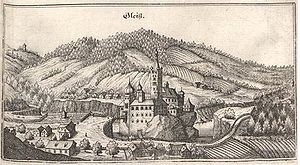Gleiß castle ruins
| Gleiß castle ruins | ||
|---|---|---|
|
Gleiß Castle around 1649, engraving by Matthäus Merian |
||
| Creation time : | 993
(first documentary mention) |
|
| Castle type : | Hilltop castle | |
| Conservation status: | Burgstall, small remains of the wall | |
| Place: | Sonntagberg | |
| Geographical location | 48 ° 0 '54 " N , 14 ° 44' 46" E | |
|
|
||
The castle ruins Gleiß (oldest spelling Gleiss / Gleyss) is an Outbound hilltop castle on a conglomeration of rock on the right bank of the Ybbs in the Eisenwurzen in Lower Austria , in the village of Gleiß the municipality Sonntagberg , 2.4 km northwest of the main town Sunday mountain itself.
history
Gleiß is the oldest evidence of settlement in the old Mark Ostarrîchi : June 15, 993, the later Emperor Otto III. a Sachso "three royal hooves in the place where the Slav Gluzo had started to live and clear and which was popularly called Gluzengisazi ('seat of Gluzo', Gleiß )." A Count Gero of Seeburg and Gleiß appears at the beginning of the 12th century, his son Wichmann († 1192) was an important politician as Archbishop of Magdeburg and advisor to Emperor Friedrich Barbarossa. He bequeathed the rule of Gleiß to the diocese of Passau , and Heinrich VI bought it at the end of the 14th century . von Walsee- Enns from the Wallseer family . In 1459 Gleiß was sold by Wolfgang V. von Walsee to Georg Gailspecker (von Gallspach ). Then the Eitzinger (also Eyczinger ) appear as owners, and in 1500 Oswald Schirmer. Baron Hofmann followed in 1542, in 1575 Gottfried von Scherfenberg was named as the owner, and in 1576 Daniel Strasser, known as the "Reiche Strasser". He was mayor and councilor of Steyr (Strasser family from / in Steyr). The rescue of the city of Steyr was largely made possible by Daniel Strasser, as he had the city rebuilt from his private assets after a devastating fire. By Emperor Ferdinand II he was enfeoffed with the rule of Gleiß in thanks. In 1605, the descendant Wolfgang Strasser Edler von und zu Gleiß - "for himself and his heirs" - also bought the Allhartsberg or Gleißer regional court from the owner of the Seisenegg estate , Johann von Greiffenberg. The castle is depicted around 1649 by the engraver Matthäus Merian . At this time the Geyer von Osterburg are the owners. The owner Anna Magdalena Geyer zu Osterburg was the granddaughter of Wolfgang Strasser von und zu Gleiß. Her remains, as well as those of her sister Dorothea, married Khöberin, can still be found in the parish church of Opponitz, which formerly belonged to the Gleiß reign. An epitaph of the nobles from and to Gleiß was found during excavations a few years ago and set into the church wall as a souvenir in Opponitz. They are followed by the Montecuccoli from 1665 to around 1700 . The Counts Orsini-Rosenberg are then lords of the castle until 1913 , interrupted from 1718 to 1760 by the Barons of Hoheneck. In 1806 the well-preserved castle was burned down by the French during the Second Napoleonic War . The castle was then not rebuilt and left to decay.
In 1913 Rudolf Freiherr Drasche-Wartinberg († September 28, 1931) came into possession of the ruin, and in 1934 the Kärntner Montanindustrie GmbH.
literature
- Rudolf Büttner: Castles and Palaces in Lower Austria, Volume 8: Between Ybbs and Enns . Birken-Verlag, Vienna 1979, ISBN 3-85030-009-9 .
- Falko Daim (Ed.): Mostviertel castles . freytag & berndt, Vienna 2007, ISBN 978-3-7079-1041-4 .
Web links
- Chronicle of the place Gleiß-Sonntagberg , sonntagberg.gv.at
- Entry about the castle ruin Gleiß at Lower Austria castles online - Institute for Reality Studies of the Middle Ages and the Early Modern Era, University of Salzburg
- Entry about Gleiss on castles-Austria
Individual evidence
- ↑ a b Sonntagberg und das Eisen ( memento of the original from October 17, 2015 in the Internet Archive ) Info: The archive link was inserted automatically and has not yet been checked. Please check the original and archive link according to the instructions and then remove this notice. , sonntagberg.gv.at, April 21, 2012, quotations literally
- ↑ to the sea burgers forg. Karl Uhlirz: Wichmann . In: Allgemeine Deutsche Biographie (ADB). Volume 42, Duncker & Humblot, Leipzig 1897, pp. 780-790.
- ↑ on this in detail Martin Hofbauer: Education and structure of the rule and ownership of the Passau bishopric in the 13th and 14th centuries (geographically, economically and socially), presented on the Passau land registers. Dissertation Helmut Schmidt University - University of the Federal Armed Forces Hamburg, Hamburg 2005, 2.3.1.4. Judicial district Waidhofen an der Ybbs , p. 251 ff ( pdf , opus.unibw-hamburg.de)
- ↑ Anton Ponte Egger: Allhartsberg and its relation to iron road . Based on the book Anton Pontesegger: Chronicle of the market town of Allhartsberg. Allhartsberg 2004 and documents on the iron road reference. Research work, Allhartsberg 2005, section Das Landgericht Allhartsberg , p. 16 ff ( pdf , eisenstrasse.info)
- ^ The drug death of Baron Rudolf Drasche at Gleiß Castle. His director Bildstein, Elfriede Pfoser and the cafetier Wilhelm Thie in court. In: Neue Freie Presse , Morgenblatt, No. 24329/1932, June 7, 1932, p. 8. (Online at ANNO ). .
- ^ Kärntner Montanindustrie GesmbH - Mines; Stone and brick grinding plants, firmen.wko.at; The Gleiß forestry office of the Carinthian coal and steel industry, in Großhollenstein not far from the train station, remembers the reasons for the rule of Gleiß - it administers around 3500 hectares in the communities of Hollenstein, Opponitz, St. Georgen am Reith and Ybbsitz. Pontesegger: Allhartsberg and its relation to Eisenstrasse , p. 18

